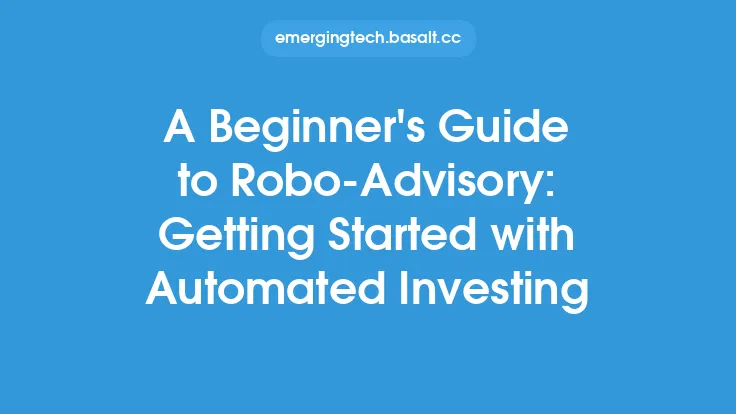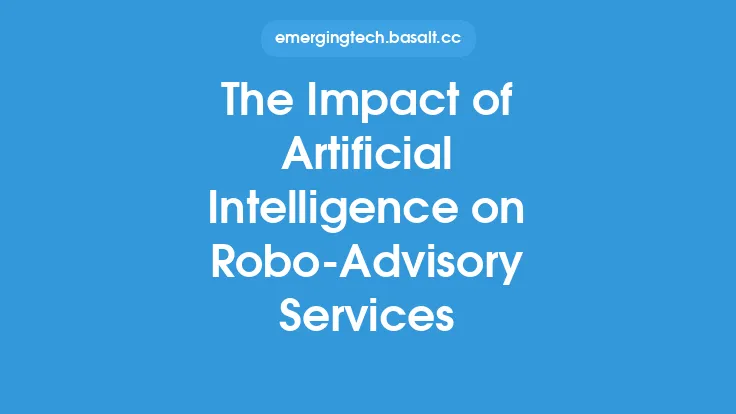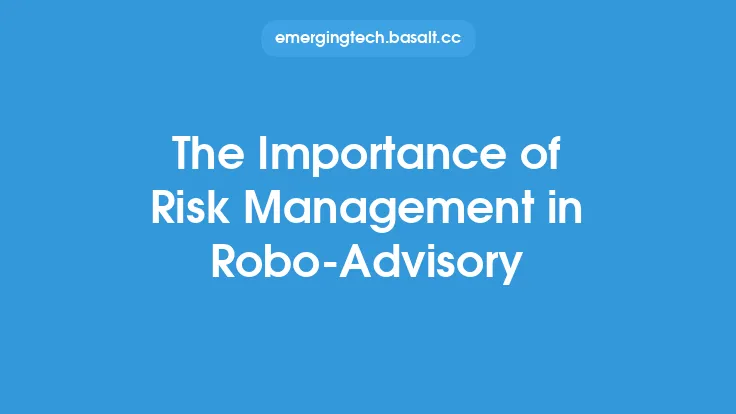The financial technology (fintech) industry has witnessed significant growth in recent years, with robo-advisory platforms being one of the most notable developments. These platforms have transformed the way people invest and manage their finances, offering a range of benefits, including low costs, ease of use, and diversified investment portfolios. In this article, we will delve into the world of robo-advisory platforms, exploring their history, architecture, features, and advantages.
History of Robo-Advisory Platforms
The concept of robo-advisory platforms emerged in the early 2000s, with the launch of the first online investment platforms. However, it wasn't until the 2010s that these platforms gained popularity, with the introduction of automated investment algorithms and machine learning techniques. The first robo-advisory platform, Betterment, was launched in 2008, followed by Wealthfront in 2009. Since then, numerous other platforms have entered the market, including Schwab Intelligent Portfolios, Vanguard Personal Advisor Services, and Nutmeg.
Architecture of Robo-Advisory Platforms
Robo-advisory platforms are built on a complex architecture that involves multiple components, including data ingestion, risk assessment, portfolio optimization, and execution. The architecture typically consists of the following layers:
- Data Ingestion Layer: This layer is responsible for collecting and processing large amounts of data, including market data, economic indicators, and client information.
- Risk Assessment Layer: This layer uses advanced algorithms to assess the client's risk tolerance, investment goals, and financial situation.
- Portfolio Optimization Layer: This layer uses optimization techniques, such as mean-variance optimization, to create a diversified investment portfolio that meets the client's risk and return requirements.
- Execution Layer: This layer is responsible for executing trades and managing the client's portfolio, including rebalancing and tax optimization.
- User Interface Layer: This layer provides a user-friendly interface for clients to interact with the platform, view their portfolio, and make changes to their investment strategy.
Features of Robo-Advisory Platforms
Robo-advisory platforms offer a range of features that make them attractive to investors, including:
- Low Costs: Robo-advisory platforms typically charge lower fees than traditional financial advisors, making them a cost-effective option for investors.
- Diversified Investment Portfolios: Robo-advisory platforms use advanced algorithms to create diversified investment portfolios that minimize risk and maximize returns.
- Ease of Use: Robo-advisory platforms provide a user-friendly interface that makes it easy for investors to manage their portfolios and make changes to their investment strategy.
- Tax Optimization: Robo-advisory platforms use tax optimization techniques, such as tax-loss harvesting, to minimize tax liabilities and maximize after-tax returns.
- Rebalancing: Robo-advisory platforms automatically rebalance portfolios to ensure that they remain aligned with the client's investment goals and risk tolerance.
Advantages of Robo-Advisory Platforms
Robo-advisory platforms offer several advantages over traditional financial advisors, including:
- Scalability: Robo-advisory platforms can handle a large number of clients, making them a scalable solution for investors.
- Consistency: Robo-advisory platforms use advanced algorithms to ensure consistency in investment decisions, reducing the risk of human bias.
- Transparency: Robo-advisory platforms provide transparent investment portfolios and fees, making it easy for investors to understand their investments.
- Accessibility: Robo-advisory platforms are accessible online, making it easy for investors to manage their portfolios from anywhere.
- Education: Robo-advisory platforms often provide educational resources and tools to help investors make informed investment decisions.
Technical Requirements of Robo-Advisory Platforms
Robo-advisory platforms require advanced technical infrastructure to operate efficiently, including:
- Cloud Computing: Robo-advisory platforms use cloud computing to process large amounts of data and scale their operations.
- Artificial Intelligence: Robo-advisory platforms use artificial intelligence and machine learning techniques to optimize investment portfolios and minimize risk.
- Data Analytics: Robo-advisory platforms use data analytics to analyze market trends and make informed investment decisions.
- Cybersecurity: Robo-advisory platforms require advanced cybersecurity measures to protect client data and prevent cyber attacks.
- Compliance: Robo-advisory platforms must comply with regulatory requirements, including anti-money laundering and know-your-customer regulations.
Security Measures of Robo-Advisory Platforms
Robo-advisory platforms take several security measures to protect client data and prevent cyber attacks, including:
- Encryption: Robo-advisory platforms use encryption to protect client data and prevent unauthorized access.
- Firewalls: Robo-advisory platforms use firewalls to prevent cyber attacks and protect their systems.
- Two-Factor Authentication: Robo-advisory platforms use two-factor authentication to verify client identities and prevent unauthorized access.
- Regular Security Audits: Robo-advisory platforms conduct regular security audits to identify vulnerabilities and prevent cyber attacks.
- Compliance with Regulatory Requirements: Robo-advisory platforms comply with regulatory requirements, including anti-money laundering and know-your-customer regulations, to prevent financial crimes.
Conclusion
Robo-advisory platforms have revolutionized the way people invest and manage their finances, offering a range of benefits, including low costs, ease of use, and diversified investment portfolios. These platforms use advanced algorithms and machine learning techniques to optimize investment portfolios and minimize risk. With their scalability, consistency, transparency, accessibility, and educational resources, robo-advisory platforms are an attractive option for investors. As the fintech industry continues to evolve, we can expect to see further innovations in robo-advisory platforms, including the use of artificial intelligence, blockchain, and other emerging technologies.





